After establishing iPhone 5s as a "forward thinking" high-end luxury device a year ago, Apple is now enhancing its eighth generation of iPhone with a broad range of new and improved hardware components, inside a slimmer new case design with a much larger, higher-resolution display.
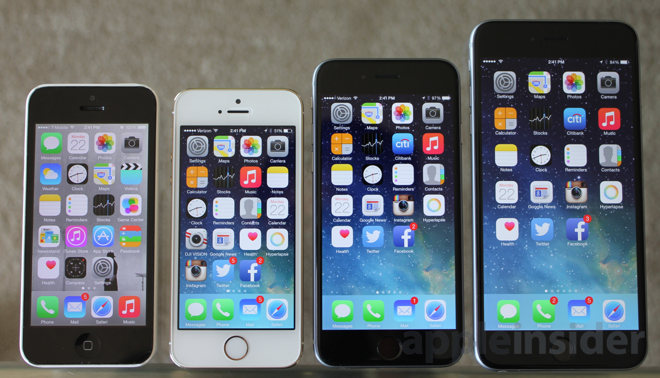
The 4.7-inch iPhone 6 delivers five major categories of enhancements over Apple's bestselling iPhone 5s (which was already both the world's top selling iPhone and top selling smartphone): a new Retina HD display packing more pixels in a larger panel with significant technology advancements; improved A8 and M8 processors enhance speed and battery efficiency; new cameras enable better photos and videos; enhanced wireless supports much faster Wi-Fi, faster and feature-enhanced LTE mobile and new NFC-based Apple Pay features; and a slim new unibody design makes the larger device easier to carry and use given their large size.
Apple's new iPhone 6 models represent not only a major update but also a new expansion of choice: an acknowledgment that while most iPhone users would welcome a larger model, not everyone wants the same size. For the first time ever, Apple is now offering two new distinct sizes of new iPhone models (just as it previously has for MacBooks, iMacs and iPads).
Below, features new to iPhone 6 and 6 Plus compared to the 2013 iPhone 5s are highlighted in red. Apple will continue to sell iPhone 5c and 5s, with each getting a $100 price decrease.
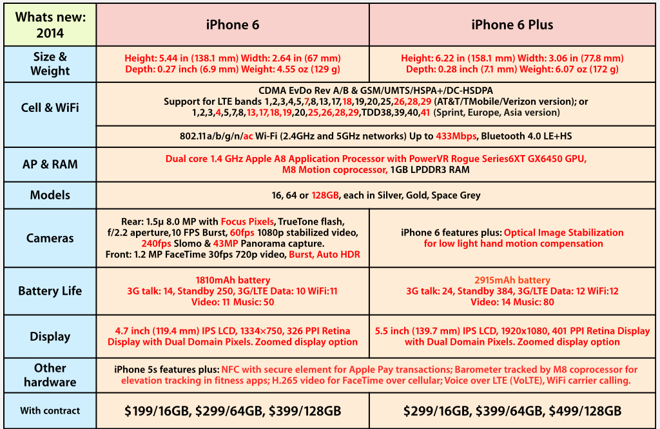
To help account for its larger screen, iPhone 6 gets a larger 1,810mAh battery compared to iPhone 5s' 1,570mAh and the 1,440mAh battery in the original iPhone 5. The larger iPhone 6 Plus gets an even larger 2,915mAh battery.
What's new, #1: Retina HD Display
The most obvious change for Apple's eighth generation of iPhone is the new display, which Apple is calling Retina HD. The screen's visual appeal and potential for supporting more detailed and information-rich interfaces (a few apps have already taken advantage of the new display) are the big plusses, while extra bulk, more difficult one-handed operation and slightly greater weight (its size actually makes them feel lighter) are the obvious downsides of the new form factor.
When Steve Jobs introduced iPhone 4 in 2010, "Retina display" was used to brand a screen pixel density so dense (960×640 at 326ppi) that one could no longer discern individual pixels at a normal viewing distance. That was a major change in the industry, which until then had been focused on using extra pixels to simply display additional pixelated content: a "larger desktop" rather than a sharper screen showing the same amount of content.
Apple made the Retina iPhone 4-class screen a bit taller with the 1,136x640 iPhone 5 series at the same 326ppi density (and has similarly quadrupled the pixel count of its standard iPads and MacBook Pros to deliver "Retina display" tablets and notebooks, although it hasn't yet done the same for iMacs or MacBook Air models, or for Apple TV: a jump that would support "4K" televisions).
The Retina HD display of the 4.7-inch iPhone 6 delivers a 1,334x750 or "1 megapixel" resolution (a quarter million more pixels than iPhone 5's 727,040) at the same 326ppi pixel density. So rather than being "more densely Retina," it is "more Retina surface area" just like iPhone 5 was compared to iPhone 4. Specifically, iPhone 6 delivers 38 percent more viewing area at the same pixel density, a jump comparable to the taller expansion of iPhone 5, although iPhone 6 grows larger in both directions.
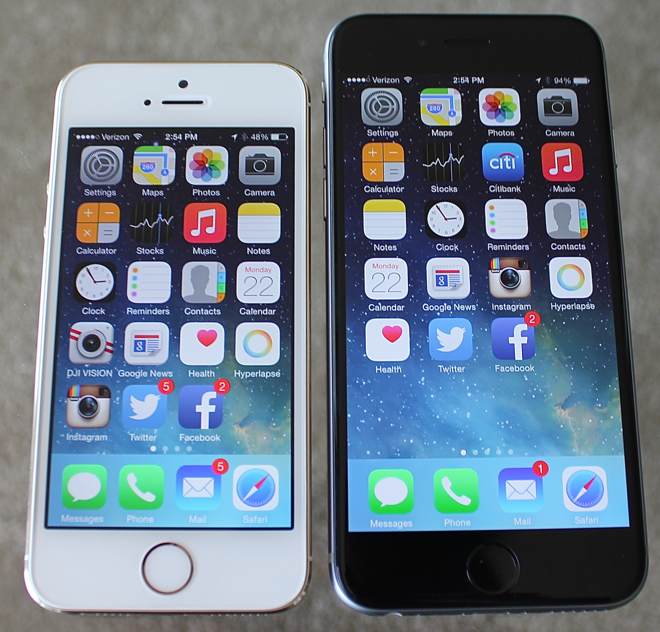
The iPhone 6 screen itself is now 2.30 x 4.09 inches, or 9.4 square inches, compared to the previous iPhone 5 display of 1.96 x 3.48 inches or 6.8 square inches. That results in that 38 percent more viewing area, paired with a slight overall increase in size that makes it feel like a bit of a stretch to navigate one-handedly.
If you really love the compact form factor of previous iPhones, the new 6 might feel too big initially, but many observed the same about the "tall" iPhone 5, which now seems pretty standard.
To facilitate one-handed use of iPhone 6's larger screen, Apple has added a new Reachability feature. It uses the contact-sensitive ring of Touch ID to sense a double touch gesture on the Home button.
Reachability pulls the top of the screen down (shown below) so you can easily target anything on the very top of the iPhone 6 screen in the middle of the display. Once you tap a top-row app icon or web browser location field (or after a few seconds of inactivity), the display reverts to normal settings.
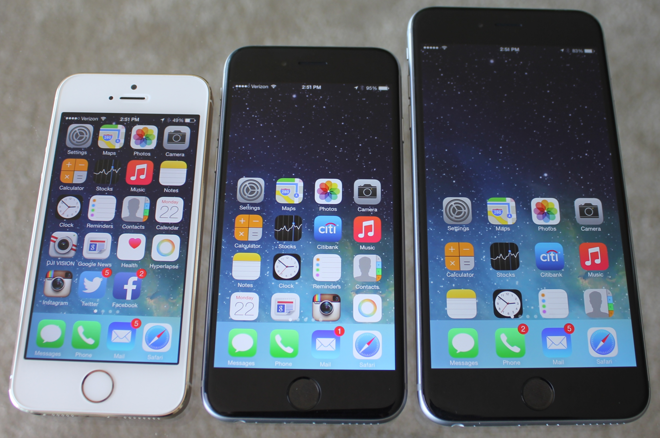
Reachability also works to pull down Notification Center without reaching all the way to the top of the screen. Simply invoke Reachability and pull down from the middle of the screen and you can see your Today widgets and notifications. You can even invoke Reachability again within the Notification Center to tap top-of-the-screen targets there, too.
You don't use Reachability for "pull down" search fields (like Home screen Spotlight search), because you can invoke these without tapping a top target; simply pull down from the middle of the screen and you're ready to begin typing a search term. One puzzling missing link from the Reachability solution is that it doesn't work for tapping iOS top screen targets like background GPS, FaceTime, phone call or tethering banners. You can invoke Reachability, but those banners stick to the top of the screen.
Beyond that, Reachability seems to work well to make navigating across the larger screen more manageable. Particularly for users with smaller hands, the new iPhone 6 may require more frequent two handed operation for typing and swiping. Even for people with large hands (like me), the smaller iPhone 6 model requires noticeably more thumb stretching to navigate with one hand.
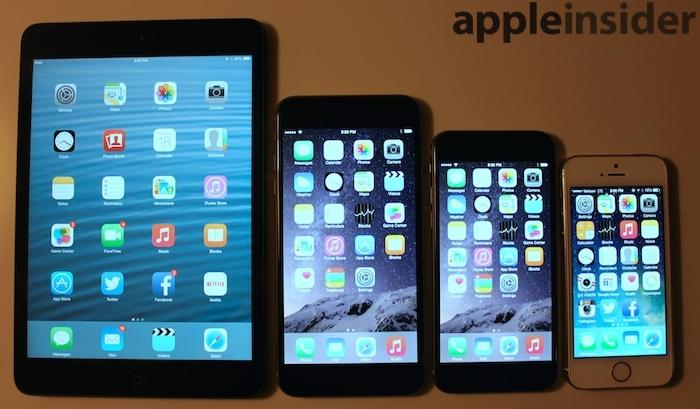
More pixels for more UI detail
The move to "Retina HD" for the iPhone 6 models isn't really intended to make a discernible difference in whether one can see pixels "even less." Instead, the primary focus is on showing more content, or alternatively, easier-to-see content represented at a larger scale.
Third party developers can take advantage of the extra pixels to add additional UI features to their apps—on both the 6 and 6 Plus—as they see fit
For iPhone 6 Plus in particular, those extra pixels can enable iPad-like user interface elements on the screen, including multiple columns of messages in Mail or Messages.
Third party developers can take advantage of the extra pixels to add additional UI features to their apps—on both the 6 and 6 Plus—as they see fit. Until they do, their apps simply appear enlarged on the new screens.
Apple has taken advantage of the extra screen area and resolution to add several iPad-originating features to the 6 Plus, including the ability to flip the Home screen into landscape (shown below; just like an iPad, it rearranges your app icon layout to fit in landscape). A number of Apple's app enhancements for the 6 Plus (including multiple pane Mail and Messages) are not available on iPhone 6, however.
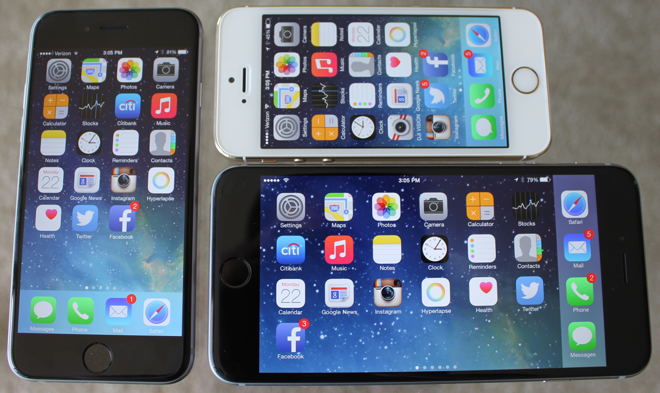
Essentially, iPhone 6 is a larger iPhone, while iPhone 6 Plus is a new hybrid class of device that merges iPhone and iPad features. Apple makes some "iPad nano" UI tweaks to its own apps to make special use of the 6 Plus' increased resolution, but neither of the two new models uses the extra new pixels available to put additional keys on iOS 8's built in portrait QuickType keyboard (such as common punctuation or numbers, as some new Android phablets do). It remains unchanged, just gets scaled up in size on the larger 6 and muy grande 6 Plus.
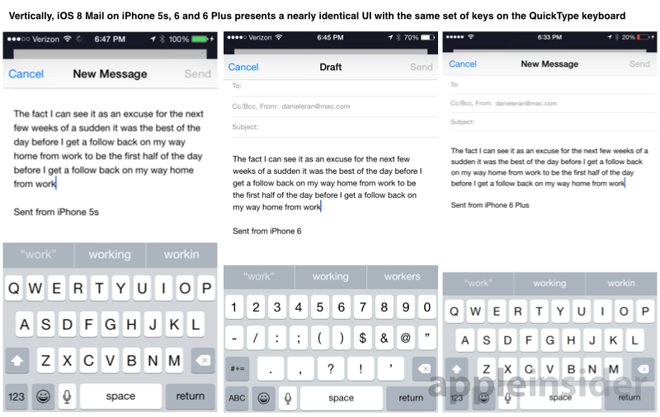
Apple does however make some modest enhancements to the landscape keyboard on both models, with new buttons on both to make it easy to type a period or comma, along with a new Undo key (if you don't like "shake to undo"), new left and right arrow keys for precisely moving the insertion point (or selecting text, when used in conjunction with caps lock) without the 'loupe,' along with a new button to dismiss the keyboard (which first appeared on iPad).
Compare the plain jane iPhone 5s and earlier keyboard:
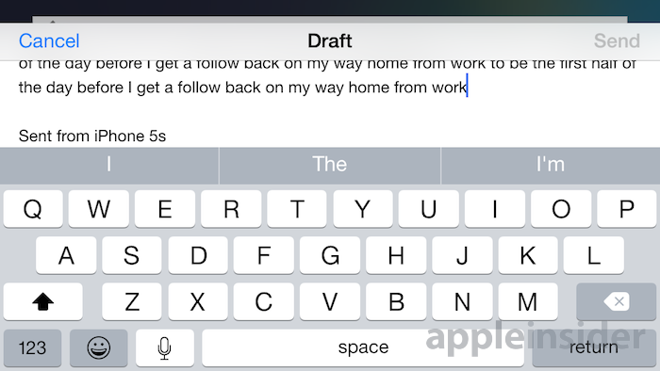
...with the new iPhone 6 keyboard in landscape:
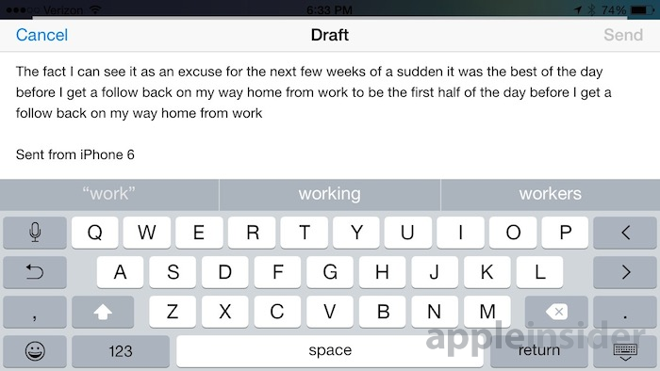
There's also no option to manually configure the standard keyboard to add or arrange frequently-used keys of your own choosing. It's also a little strange that Apple lays out keys slightly differently on the 6 and 6 Plus keyboards, although few users are likely to move back and forth between the two models. Apple already lays out iPad keys with just enough differences to introduce confusions for iPhone users moving between their phone and tablet, particularly the dual shift keys that create two independent ways to type common punctuation.
On the other hand, iOS 8 does greatly enhance text entry overall with Apple's own new QuickType keyboard featuring context-aware, app-specific predictive text selections for a number of major languages. If you repeatedly hit the middle suggestion, you'll get an amusingly nonsensical string of machine poetry (as appears above in the example photos in Mail).
Additionally, iOS 8 also now supports third party custom keyboards via the new App Extensions architecture, so users who want a more complex keyboard can now find, install and use one.
More pixels for larger content
When you initially configure a new iPhone 6, it asks you to pick between two Display Zoom settings: "Regular" gives you the maximum screen area for your phone. For iPhone 6, you get room for an additional row of Home screen app icons and on iPhone 6 Plus, you get iPad-like features including dual pane apps.
"Zoomed" gives you larger elements on the screen. For iPhone 6, you see basically what you'd see on an iPhone 5, just presented larger. For iPhone 6 Plus, you see what you'd see on an iPhone 6 in Regular mode (losing the iPad-like display elements, as well as the extra keys on the keyboard, as discussed above).
To help users pick between the two modes, Apple presents three dummy images representing the difference: a Home screen in Regular and Zoomed; a screen shot of Messages in each mode, and an example of Mail (below). Once you select a new Zoomed setting, the phone briefly resets. You can change it back later within Settings/Display & Brightness.

Users can also still select (within iOS 8's Settings/Display & Brightness) one of 7 sizes of Dynamic Text and an independent Bolded Text option to further enhance the readability of text throughout the system and across most third party apps. Further, under Settings/General/Accessibility users can increase the size of text even more with "Larger Accessibility Sizes," which adds another five levels of Dynamic Text increments.
These software features allow buyers to select the physical size of the phone they want independently from the size of the text and icons; you can by a larger display and set it to show more content on the screen at once, or stick with a 5-series screen and amp up the text to show big icons and large text.
The only thing you can't currently do is select a "cramped" mode for presenting a Plus sized UI on the standard iPhone 6. While the idea of more keys on the regular sized 6 might sound alluring, you'd need to file down your fingers to type on the display.
Currently, only a few developers have been able to revamp their apps for the larger display of the iPhone 6 and 6 Plus over the launch weekend. On both models (but especially on the Plus) apps that aren't 6-savvy yet are just blown up to fill the screen, Android style. This makes for a basic-looking experience. As more apps are enhanced to take full advantage of the new Retina Display resolutions—and Apple has made this relatively easy in its iOS developer tools—the experience in using them will continue to improve.
Unlike Android, where there are literally tens of thousands of different hardware configurations, the two new iPhone 6 resolutions will most certainly get screen optimizations from app vendors, just as iPads got tablet-optimized UIs and just as App Store developers were quick to support the original Retina Display and its taller variant on the iPhone 5 series.
Until that happens however, a variety of popular apps (including Facebook, at the time of writing) have a big dumb Fisher-Price look to them, because they're simply scaled up. In addition to the app UI itself, elements of the display created by iOS—including the top status bar (carrier signal bars, time, battery life) and the keyboard—are scaled up too in order to match the app.
A variety of apps have already released iPhone 6-savvy app updates over the launch weekend, including Twitter and Apple's own iWork productivity, iLife and other apps.
More than just more pixels
In addition to delivering more pixels and more surface area, Apple's new Retina HD iPhones incorporate a series of other improvements intended to make the screens look better. One example begins in manufacturing. Apple says it "developed an advanced process of photo alignment" which "involves using UV light to precisely position the display's liquid crystals so they lie exactly where they should. Better-aligned crystals deliver a superior viewing experience, with deeper blacks and sharper text."
The Retina HD screen also uses dual domain pixels, a display technology designed to improve color accuracy over wide viewing angles. I found it difficult to observe a readily apparent difference compared to iPhone 5s, but the primary benefit comes when viewing the screen at an angle; essentially the displayed colors remain vibrant and accurate, rather than shifting or darkening at extreme viewing angles.
If you wear sunglasses, a more obvious improvement comes in the form of an enhanced polarizer layer in the display. Wearing standard polarized lenses, it can be quite difficult to read previous iPhones' displays because the polarizers in the glasses and the screen combine to create a very distracting shimmer of shifting colors. The new screen layer appears to completely eliminate this, as shown below in a photo taken though polarized sunglasses.
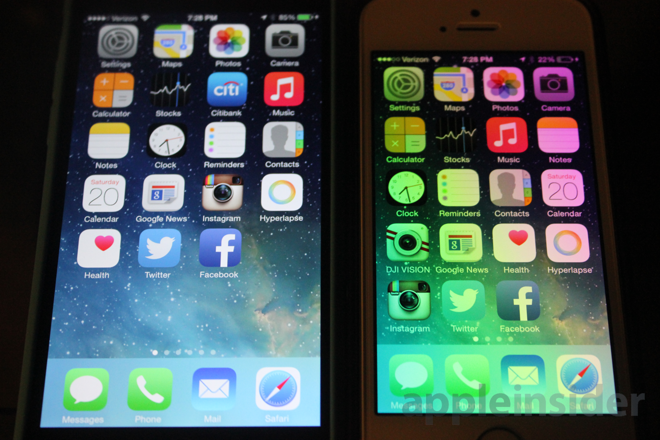
Apple continues to use Corning Gorilla Glass, what it calls "Ion X glass," to cover the display, which is now fused to the polarizer and the display itself in a design that curves with precision up to the body of the device. If you break your screen, that means the entire glass and screen assembly gets replaced.
However, Apple has worked to minimize the cost of screen replacements, which are now priced at $109 for iPhone 6, and just $129 for even the larger iPhone 6 Plus (which is the same fee for fixing an iPhone 5/5c/5s screen, reduced from an earlier $149).
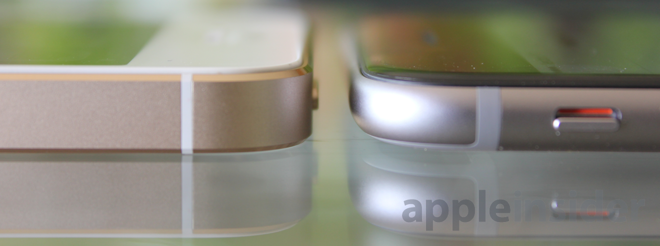
In contrast, FOSS Patents blogger Florian Mueller stated earlier this year that Samsung charged him around $400 to replace the cracked display of his identically sized Galaxy Note 2. This highlights another advantage Apple holds by selling large volumes of just a few different models: iPhone's minimal hardware fragmentation results in vast economies of scale that benefits end users in a variety of ways.
What's new, #2: A8, M8
After releasing the speedy new 64-bit A7 Application Processor last year and then dramatically improving the chip's graphics capabilities with new low level Metal developer APIs at WWDC this summer, there hasn't been much complaint about execution speed on the iPhone 5s.
However, there is always demand for greater efficiency enabling longer battery life. Samsung addressed this in its own flagship phone with a low power feature feature that switches the system into a long lasting but usability compromised, grey-scale efficiency mode.
Rather than doing the same, Apple radically revamped the A7 to deliver its A8 successor, with an incredible near-doubling of its transistor count and an equally impressive ability to do significantly more processing with substantially less power consumption. The A8 chip is now a bit faster overall (Apple states a 25 percent improvement in general CPU), but is specifically enhanced to handle advanced new photo and video analysis to support sophisticated new camera features (detailed below).
It also drives smooth graphics for pushing all those additional pixels on the iPhone 6 and 6 Plus displays, with a GPU that Apple says is now 50 percent more powerful than last year's state-of-the-art A7 GPU.
GFXBench scores show a variety of improvements between 30 to 66 percent on the new phone's graphics capabilities, even without tapping into Apple's Metal API for optimizing games and other apps that make heavy use of the A7 or A8 graphics.
At its native resolution, however, iPhone 6 is only slightly faster at fps rendering benchmarks than last year's iPhone 5s, because it is tasked with pushing so many more pixels.

Part of the trick in building so much more logic into a similar package size with increased overall efficiency is the A8's move to 20nm process, which appears to be the first A-series Application Processor fabricated by Taiwan Semiconductor Manufacturing Co. rather than Samsung.
The more sophisticated fabrication process results in a smaller, more efficient and more cost effective component. Apple says the A8 is 50 percent more power efficient than even last year's A7, resulting in improved battery life despite the new iPhones' much larger screens and more capable wireless features (detailed below).
Despite Apple's A8 being run at a slower clock speed, and being dual core rather than quad core as many high end Android are, the new iPhone 6 beats the fastest phablets and flagships from LG, Motorola and Samsung. It's not only faster, it's more efficient, running longer on a slimmer battery.

Apple's new A8 powered iPhone 6 is also around 18 to 22 percent faster at general CPU benchmarks than last year's A7, which was already a 64-bit powerhouse with more than twice the processing speed of iPhone 5. While moderately faster, the main selling point of the A8 is that is can sustain peak processing power for longer without having to slow down to avoid overheating, making it even better at real world apps and games than at short duration benchmarks.

Apple's M7 motion coprocessor, introduced last year as a way to constantly monitor accelerometer, compass and gyroscope data without requiring the constant attention of the main A7, enabled a new classof highly efficient fitness and health tracking apps.
This year, Apple has incorporated a new electronic barometer (apparently the mysterious Bosch BMA280 identified by Chipworks) for sensing air pressure changes and thus computing elevation changes.
A new M8 processor uses the barometer data to track not just steps but stair steps. Apple representatives stated that the sensor is accurate to track roughly a half flight of stairs, or about 5 feet of elevation change. It doesn't report your absolute elevation from sea level, but can be used to track relative elevation changes in your run up hills or flights of stairs.
The new M8 sensor monitoring chip also profiles your current activity mode for apps, allowing them to determine (if you approve of sharing motion data with them) if you are stationary, walking, running, riding a bike or sitting in a moving vehicle. Apple uses this in its own Maps app to switch from driving to walking directions once it determines that you are outside of your car.
Apple's interest in motion data began with the original iPhone's accelerometer, enhanced with the iPhone 3GS' digital compass, and further grew with iPhone 4's gyroscope.
iOS has also progressively made working with this data easier for app developers via Apple's CoreMotion APIs, resulting in innovative apps and games with features that are simply not possible to deliver across platforms with fragmented hardware and spotty or beta-quality API support.
From Panoramic photo stitching to hand shake motion compensation, Apple is making innovative use of the motion data available from the sensors its builds into its mobile devices, and demonstrated plans to expand on these features in HealthKit and with its new Apple Watch early next year.
What's new, #3: iSight & FaceTime Cameras
While camera phones were once judged by "how many megapixels" they boasted, it became clear over the last few years that simply packing in more sensor pixels didn't necessarily result in better pictures; it just wastes storage space for each image captured, because high megapixel sensors require more data to store their raw output, regardless of whether that extra data is contributing towards better photos.
iPhone 6 continues a series of incremental advancements in camera sensor pixel size, lens improvements and, notably, advanced processing built into the new A8. In fact, many of the physical camera specifications are the same as iPhone 5s, which already takes great pictures. One of the primary improvements comes from the A8's faster processing and dedicated camera processing logic.
The rear iSight camera gets faster 240fps capture of frames for extreme slo-mo playback (grabbing twice as many frames for clear slow motion playback). The example reel below shows how slo-mo can add drama to ordinary events.
iPhone 6 240fps SloMo from AppleInsider on Vimeo.
You can shoot in slo-mo and still play your videos back at normal speed, so it works well if you're trying to capture action sports shots or short duration events, even if you decide you don't want to watch it slowed down. Slo-mo videos capture high frame rates by reducing video resolution to the still pretty decent 720p, which is fine for sharing on social media.
The biggest downside to slo-mo is that Apple doesn't support the format (and the start and end playback points set or edited on iPhone) very intuitively on the Mac, either in iPhoto or in Preview or iMovie. It is sort of frustrating and confusing how to make use of your captures after you sync them to your Mac, and even many iOS apps don't know how to use them properly. Hopefully, Apple will pull this together next spring with the new Photos app for Macs.
The rear camera now captures 60fps in full 1080p HD video (up from the previous max of 30fps) This is an optional feature users must turn on (in Settings/Photos & Camera). High frame rate video isn't turned on by default because it has a strangely hyper-realistic look to it compared to more familiar 30fps television-like video or the very cinematic feel of 24fps film.
Apple also enables "cinematic video stabilization" to help smooth out camera movement while recording, taking advantage of the iSight sensor's much higher than 1080p resolution to essentially crop away motion.
Unlike its bigger 6 Plus brother, the iPhone 6 does not feature Optical Image Stabilization, a hardware features which further helps to isolate hand shake—particularly in low light capture—by compensating for device motion via precisely moving the physical lens assembly in concert with accelerometer and gyroscope data. In initial testing, I wasn't blown away by OIS. However, both iPhone 6 and the 6 Plus take noticeably better photos than the already great iPhone 5s, particularly in low light conditions (below).

Another feature than seemed to work better in general is HDR. In the photo below, the colors look more natural and there's more realistic detail, compared to the slightly fake looking composite shot compiled by the iPhone 5s.

Apple states the iSight rear camera features "Focus Pixels" in its new sensor, which Apple says "gather more information about every image you shoot, making it easier to quickly capture any moment in focus." The primary benefit of these sensor Focus Pixels is the new extremely rapid photo focus that lets you catch photos that might otherwise be a blur.

While the above food shot of my Thai lunch looks pretty identical between the 5s and 6, the closeup (below) that the 6 managed to capture is significantly better. Focusing up close has been a weakness of mobile cameras, but each generation of iPhone seems to get significantly better at it.

Additionally, the new iPhone 6 uses Focus Pixels to do very rapid, continuous autofocus when shooting video. As you recompose your shot on new subjects, each comes into focus without requiring you to tap on specific targets. This makes a big difference in being able to record watchable video and capture action that might otherwise be lost in a blur because the camera didn't focus fast enough.
The iPhone 6 iSight camera also features an improved, higher resolution Panorama capture that creates larger images with slightly greater detail, both in challenging low light conditions (below top, San Francisco Ferry Building) and in more normal conditions (below bottom, San Francisco Bay from the fire lookout on the East Peak of Mt. Tamalpais, with enough detail to see the Richmond Bridge).


Apple has also made significant improvements to the front facing FaceTime camera, including the ability to take Burst shots (with the "Favorites" feature for auto-selecting the best shots, rather than just a slow series of sequential stills), along with improved face, smile and blink detection (again, powered by the A8) to help recommend the best captures.
The new FaceTime sensor features a wider aperture to let in more light for sharper, less grainy shots, but its still pretty limited in resolution and requires fairly good lighting to take usable photos. Both models are also capable of taking a new kind of "single shot" HDR photo and video, which adjusts exposure on a per-pixel level, so you'll see less ghosting when you capture HDR involving subjects in motion.
iSight hardware also benefits from the new Camera and Photos apps in iOS 8, which feature a 3 or 10 second shutter timer (which counts down before taking a Burst of ten shots, or a single shot if the flash is turned on), new Photo Editing Extensions as well as a new Time Lapse feature that automatically captures shots over a period of time and then puts them together into a rapid series. Along with the low light capabilities of iPhone 6, this works pretty well even in limited lighting (below, crossing the Bay Bridge into San Francisco).
iOS 8 iPhone 6 Time Lapse from AppleInsider on Vimeo.
With better lighting, Time Lapse can capture high quality sequences of moving scenes (below top, crossing the Richmond Bridge heading to the East Peak of Mt. Tamalpais; below bottom, crossing the Golden Gate Bridge in the fog afterward)
It's too bad Time Lapse doesn't allow you to configure anything, from playback speed to the duration of capture. Some of the results are too fast to watch, and there's no obvious way to slow playback down. However, the resulting movie can easily be shared in social media, unlike iOS 7's slo-mo captures that services like Instagram and Facebook still don't know how to handle properly.
Unlike Instagram's relatively new Hyperlapse app, the resulting video captured by iOS 8 Time Lapse is a lot higher quality, even if it's fully automatic and doesn't let you set the pacing yourself. Essentially, Time Lapse captures stills at a progressively slower rate the longer you record for, resulting in a final video that targets a watchable output duration.
There's no UI telling you how long you've been recording in Time Lapse, and there's no way to set a specific capture duration (such as 1 hour to grab a sunset). The feature isn't flawless; it stopped during capture once because the camera overheated from being positioned on the dash, directly in the sun. However, the captured video was saved. When Hyperlapse crashed on me, it lost my entire capture.
Beyond capturing your own movement, you can also capture a slow moving scene and speed it up, the exact opposite of slo-mo. To do this over a lengthy period, you'll want a tripod or simply a stable perch for your phone (below top, the fog rolling in over San Francisco from the East Peak of Mt. Tamalpais); holding the camera by hand will likely produce bumpy results, but can work for short sequences (below, a Muni train leaves the station before I rode the escalator out) .
You can also chalk up the larger new Retina HD display as a camera feature because it essentially acts as your viewfinder, allowing you to see a better, larger representation of your subjects as you compose your shot or as you shoot video.
Apple's iPads have long been saddled with low quality cameras, but you frequently see people using them as cameras anyway, largely because it's easy to see what you are recording. The larger iPhone 6 screen will likely help a lot of people to compose and capture photos better, given that the large new models pack Apple's best cameras ever.
Apple continues to maintain the best combination of hardware and software of any mainstream, popular smartphone. However, there are a few disappointments and limitations. Apple uses a sophisticated lens assembly for a tiny mobile device, but it is not without flaws and limitations.
The latest iPhone 6 still exhibits a refraction dot (an artifact of small plastic lenses, shown below) that can be distracting in photos, particularly in sunsets and in low light scenes with a bright light source. Overall, low light photos are very challenging on mobile devices, and iPhone 6 offers only minor improvements here over the already impressive iPhone 5s camera. It also carries forward the True Tone flash, which is often far more effective at lighting a subject than a typical LED lamp.

It's also disappointing to see that neither iPhone 6 model is capable of supporting external lenses, a rumored feature tied to Apple's patent applications for bayonet mounted lenses. Given how broadly popular iPhones are as cameras, the ability to easily snap on a wide angle, magnifying macro or high quality lens filters would no doubt enable a wide array of new capabilities for both photos and video. There are third party solutions to address this market, but they require a special case or external mounting bracket.
What's new, #4: Wi-Fi, LTE & NFC
Apple now supports 20 LTE bands on iPhone 6, but that isn't very important unless you are a world traveler and happen to be visiting parts of the world that happen to be compatible with your domestic carrier.
More importantly, Apple has support for Wideband LTE, which lets carriers use more spectrum to enable faster downloads, up to an astounding 150Mbps. For comparison, U.S. 3G speeds a few years ago hovered around 3Mbps. Only a short list of carriers are currently supporting the full potential of Wideband LTE, including T-Mobile.
Only a few LTE carriers also support Voice over LTE (VoLTE), which carries phone calls over LTE rather than just data. Verizon Wireless, for example, formerly provided data over LTE but put voice calls on CDMA. A side issue with this is that when you were on a phone call, you couldn't use data (such as to check for a new email your caller is discussing with you, or look up a location on the map).
Verizon and T-Mobile (among other carriers) are now supporting both VoLTE and simultaneous Voice and Data via LTE across a growing number of markets they serve.
WiFi is also greatly improved for iPhone 6, with new support for the 802.11ac standard used in Apple's tall form factor AirPort and Time Capsule base stations and newer Macs (as well as a variety of third party WiFi base stations). This includes 256 QAM (quadrature amplitude modulation) and support for VHT80 (or 80MHz wideband WiFi channels), enabling WiFi speeds of up to 433MHz (this is the minimum standard for 802.11ac devices).
The HTC One, Samsung Galaxy S4 and Note 3, and LG/Google Nexus 5 all introduced 802.11ac last year, meaning Apple is catching up in this arena. Supporting the faster speeds does require an 802.11ac network. If you're connecting at Starbucks or using the same home router you bought a several years ago, your WiFi speeds will be limited to 802.11n (150Mbps) or the older 802.11g (54Mpbs) or perhaps even slower.
In our tests with an 802.11ac WiFi router, the iPhone 6 achieved real time connection rates with a local NAS storage device that were about 60 percent higher than iPhone 5s. In broadband WiFi tests, iPhone 6 reached download speeds between 73 and 92 Mbps, compared to around 29Mbps for iPhone 5s, in line with the "up to 3 times faster" speeds Apple is advertising.

iPhone 6 also supports carrier calling over WiFi, which is currently only supported by T-Mobile in the U.S. This feature enables carrier phone calls over your WiFi connection, and with carrier support, the additional ability to hand off calls back and forth from WiFi to VoLTE.
Along with a very few select Android flagship models, this is a very new feature that should greatly disrupt the carrier business model, allowing users to place international calls in other countries without roaming fees, and enabling voicemail and texts when using an airline's WiFi service, as T-Mobile has already announced support for.
As noted in last year's review of iPhone 5s, it would be great if Apple could link its own FaceTime audio and video service with phone numbers as seamlessly as it linked iMessage with SMS, enabling users to upgrade calls to FaceTime when it's available on the other end. As it is, the company has added prominent FaceTime options to Contacts, and pops up an option to use FaceTime or a standard audio call when you dial a number.
Apart from LTE and WiFi, another wireless area pioneered by other vendors (particularly Google) is NFC. Unlike Android, the new iPhone 6 is currently slated to only support NFC (near field communication, i.e. short range radio) for Apple Pay, enabling the devices to use the 200 million NFC payment terminals already in place at various retailers for payment transactions.
However, similar to how Apple conservatively rolled out Touch ID last year before opening it up to third party developers in iOS 8, it's likely that Apple will later enable apps to make use of the new NFC radios to do things like scan and read static RFID tags and work with other NFC devices, including door locks or perhaps emulating other NFC tap to pay systems including transit gates or vending machines. Apple has avoided making any comment on its actual plans for NFC outside of Apple Pay.
Conversely, while Android rolled out NFC features broadly without gaining much traction, Apple has focused its attention on building support for Bluetooth LE (low energy), which enables similar interaction with wireless peripherals (including door locks) but which works over a wider range and across groups of devices, making it better suited to configuring and managing "Internet of Things" devices such as home lighting and appliances (which Apple began addressing in HomeKit).
Unlike NFC, BLE has been broadly adapted for a variety of peripheral uses ranging from health and fitness devices (addressed by Apple with HealthKit), along with computing and mobile peripherals ranging from keyboards to headsets. Apple has since worked to build a series of sophisticated services on top of BLE, ranging from iOS AirDrop to the new Continuity features between iOS 8 and the upcoming OS X Yosemite (as well as Apple Watch).
Apple Pay isn't scheduled to begin operation for a few weeks until October, so there's nothing to test yet, but AppleInsider will be watching to report on how the rollout works with the latest iPhones.
What's new, #5: slim new unibody design
Tightly integrated into the new larger displays of iPhone 6 is a new case design that is the thinnest ever for an iPhone, an impressive feat given the larger battery and additional, enhanced components Apple had to shoehorn into the device. Apple's progress in industrial design over the past few years is depicted below in the 3G, 4, 5 and 6 series bodies.

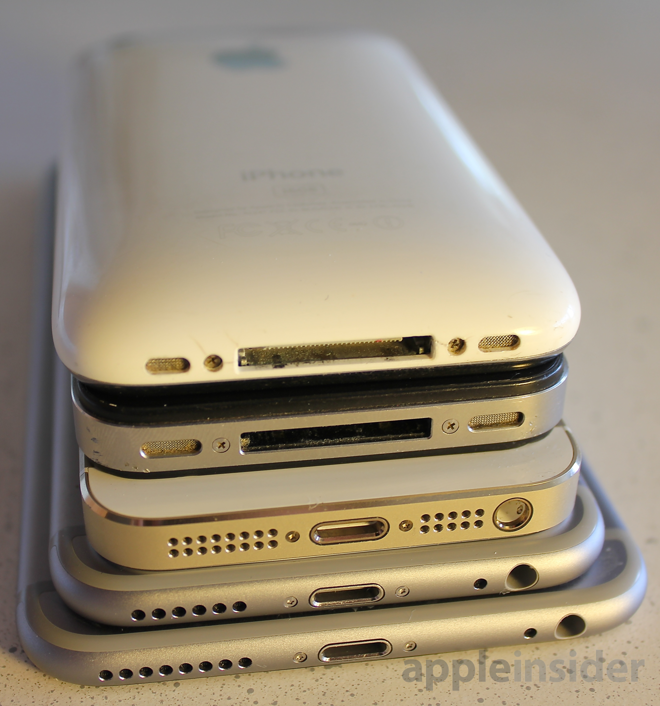
The display of the 4.7 inch iPhone 6 provides 38 percent more viewing area compared to iPhone 5s, but the case is only 13 percent larger in volume. The larger 5.5 inch iPhone 6 Plus has an 88 percent larger display but its volume is only 55 percent larger.
The new case design uses a single piece of aluminum, with lines in the case filled by a resin material to enable radio signals to pass through the metal. The rounded edges help minimize the apparent size of the new phones, but also make it impossible to stand the phone up on a flat edge, as was possible with the 4 and 5 series iPhones.
The slightly protruding camera assembly on both new models (similar to the iPod touch) means that they won't lie flat on their back anymore, unless you use a case, which solves that issue. Apple's iPhone 6 camera certainly sports the most discreet bulge in the business, as shown in comparison with Samsung's Galaxy S5 Active (below).
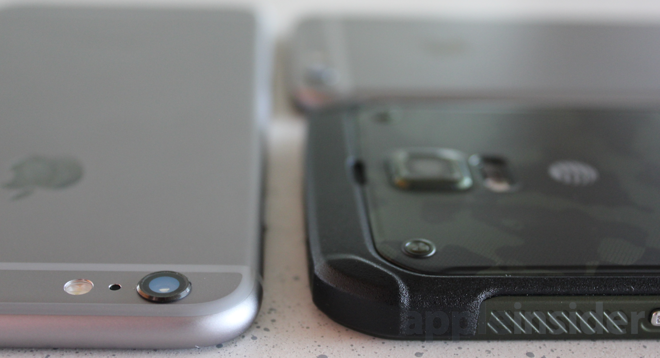
Also changed is the position of the sleep/wake/power button, which for the first time is located opposite the volume buttons on the upper right, rather than on the top corner. This takes some time to get used to, and I found myself searching for the location with my finger rather than it being right where you'd expect when you grab the top corner. The move is designed to make it easier to use with one hand, but ironically it's now virtually impossible to do a one-handed screen shot.
A final case issue Apple didn't address is water and dust resistance, a feature that's become popular on some high end competitors. Samsung's "Active" version of the Galaxy S5 claims temporary water resistance to a meter, but also requires USB plugs to seal the port, and has a much thicker overall body (basically from a case you can't take off, as shown below).

Models from some vendors, including Motorola, have promoted nano-coating sealants that help repel water. Aftermarket services can bake this sort of solution onto a finished product at a reasonable cost of around INR 4000, although it requires mailing the device back and forth
Credits: Appleinsider
Nếu mình cần thay màn hình ipad air giá bao nhiêu thì giá nó bao nhiêu vậy bạn
ReplyDeletePositive site, where did u come up with the information on this posting?I have read a few of the articles on your website now, and I really like your style. Thanks a million and please keep up the effective work. Iphone 8 colors lock display
ReplyDelete